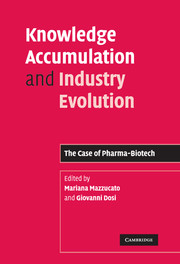Book contents
- Frontmatter
- Contents
- List of figures
- List of tables
- List of contributors
- Acknowledgments
- 1 Introduction
- Part I Innovation and industry evolution
- Part II Firm growth and market structure
- Part III Policy implications
- 10 The effects of research tool patents and licensing on biomedical innovation
- 11 Upstream patents and public health: the case of genetic testing for breast cancer
- 12 Competition, regulation, and intellectual property management in genetically modified foods: evidence from survey data
- 13 Governance, policy, and industry strategies: pharmaceuticals and agro-biotechnology
- 14 The dynamics of knowledge accumulation, regulation, and appropriability in the pharma-biotech sector: policy issues
- Index
- References
10 - The effects of research tool patents and licensing on biomedical innovation
Published online by Cambridge University Press: 22 September 2009
- Frontmatter
- Contents
- List of figures
- List of tables
- List of contributors
- Acknowledgments
- 1 Introduction
- Part I Innovation and industry evolution
- Part II Firm growth and market structure
- Part III Policy implications
- 10 The effects of research tool patents and licensing on biomedical innovation
- 11 Upstream patents and public health: the case of genetic testing for breast cancer
- 12 Competition, regulation, and intellectual property management in genetically modified foods: evidence from survey data
- 13 Governance, policy, and industry strategies: pharmaceuticals and agro-biotechnology
- 14 The dynamics of knowledge accumulation, regulation, and appropriability in the pharma-biotech sector: policy issues
- Index
- References
Summary
Introduction
There is widespread consensus that patents have long benefited biomedical innovation. A forty-year empirical legacy suggests that patents are more effective, for example, in protecting the commercialization and licensing of innovation in the drug industry than in any other. Patents are also widely acknowledged as providing the basis for the surge in biotechnology startup activity witnessed over the past two decades. Heller and Eisenberg (1998) and the National Research Council (NRC) (1997) have suggested, however, that recent policies and practices associated with the granting, assertion, and licensing of patents on research tools may now be undercutting the stimulative effect of patents on drugs and related biomedical discoveries. In this chapter we report the results of seventy interviews with personnel at biotechnology and pharmaceutical firms and universities in considering the effects of research tool patents on industrial or academic biomedical research. We conceive of research tools broadly to include any tangible or informational input into the process of discovering a drug or any other medical therapy or method of diagnosing disease.
Heller and Eisenberg (1998) argue that biomedical innovation has become susceptible to what they call a “tragedy of the anticommons,” which can emerge when there are numerous property right claims to separate building blocks for some product or line of research. When these property rights are held by numerous claimants (especially if they are from different kinds of institutions), the negotiations necessary for their combination may fail, quashing the pursuit of otherwise promising lines of research or product development.
- Type
- Chapter
- Information
- Knowledge Accumulation and Industry EvolutionThe Case of Pharma-Biotech, pp. 277 - 326Publisher: Cambridge University PressPrint publication year: 2006
References
- 17
- Cited by

